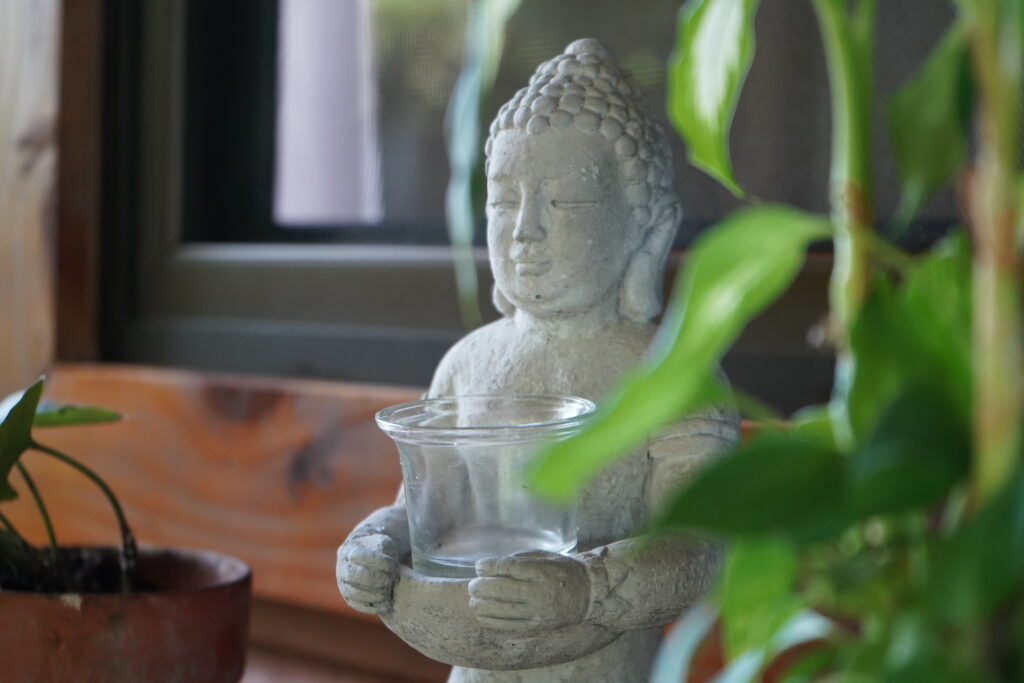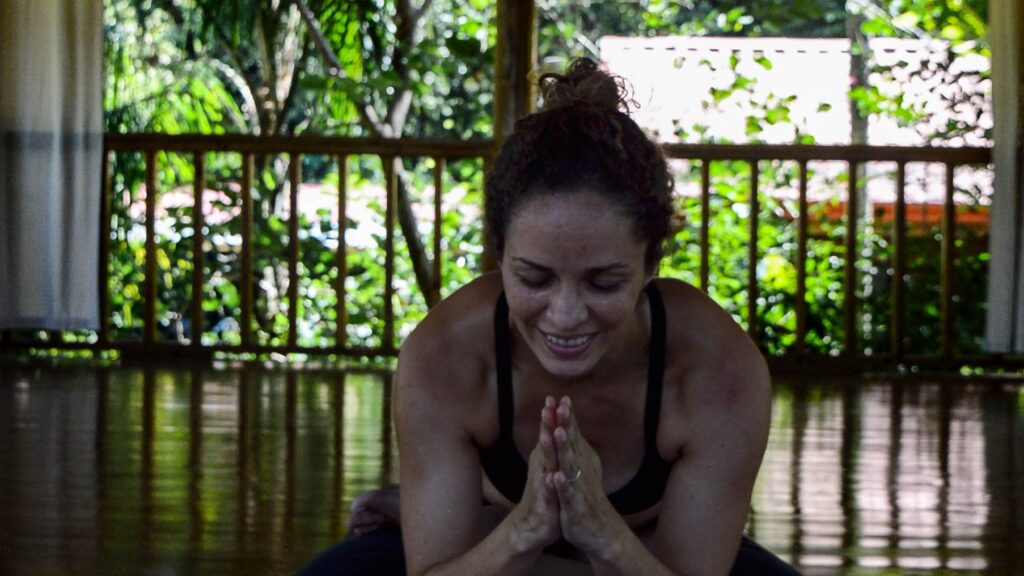Understanding the Meaning of Namaste in Yoga
Saying Namaste at the end of a yoga practice is a respectful way to say “thank you” by acknowledging the teacher and the other people you’ve practiced with. It is often described as “the light in me honors and bows to the light in you.” Light in this context could mean spirit, consciousness, or being. It is an expression of reverence to all beings, acknowledging that we are all connected, and is often used at the end of Asana to honor your practice.
When we say Namaste we are creating an internal connection with those around us. It develops compassion and acknowledgment towards others, regardless of the differences we show up to the mat with. Although Yoga can be viewed as a solo practice, the philosophy of Yoga teaches us that we practice in unison with all beings on Earth. Through Yoga, we cultivate oneness in the mind, body, and spirit, and it’s this oneness in ourselves that eventually leads us to see the oneness amongst all beings.
Namaste is said with the palms flat against each other in front of the heart in a prayer position, sometimes called Namaskar. The word namaskar is often used in India to address people who are spiritually significant and highly respected. This is clear when we consider sun salutation—Surya Namaskar—a practice designed to respectfully greet the sun.

The Cultural Significance of Namaste
The word Namaste is Sanskrit and comes from the Vedas, the ancient texts from which Hinduism sprouted. The Vedas are thought to have come from the areas that are now Pakistan and northern India. Over time, the Sanskrit words, which mean “to bend in reverence to a deity,” evolved into a simple greeting. In modern-day India, Namaste might not have any spiritual significance attached to it—similar to how in the West we say “bless you,” which is short for “God bless you,” to someone after they’ve sneezed.
Remember that although the word is commonly used, it might still be offensive if used without understanding its significance or historical context. Using Namaste without acknowledging its origins could be seen as exploiting the cultural practice of others just because it’s trendy. It’s important to approach Yoga and all its Eastern roots with respect and a willingness to learn.
Anjali Mudra — Prayer Hands
The hand gesture of bringing the palms to meet in front of the heart is called Añjali Mudrā. This hand position alone is a sign of respect towards another person and is found in Indian, Hindu, Buddhist, Jain, and Sikh traditions. In these cultures, bowing in front of another person, such as elders, teachers, or deities, is a sign of deep respect. In India, saying Namaste is more of a respectful greeting, like saying hello, and is not necessarily seen as part of yoga.
In addition to Namaste, the prayer hand Mudra is also common in Indian classical dance and in yoga Asana poses, such as the standing prayer position called Pranamasana. Yoga hand Mudras are used in both Asana and Pranayama practices to stimulate the body and concentrate the mind. Practicing hand Mudras is thought to channel specific energies and enhance focus during meditation.
Common Yoga Hand Mudras
- Gyan Mudra (Gesture of Knowledge): Formed by touching the tip of the thumb to the tip of the index finger. It symbolizes wisdom and is thought to enhance concentration during meditation.
- Prithvi Mudra (Earth Mudra): Created by joining the tip of the thumb with the tip of the ring finger. It is believed to increase strength, stability, and vitality.
- Varun Mudra (Water Mudra): This mudra is formed by touching the tip of the thumb to the tip of the little finger. It is thought to balance the water element in the body, aiding in hydration, fluid balance, and emotional harmony.
- Apana Mudra (Energy Mudra): Made by joining the tips of the thumb, middle finger, and ring finger while keeping the other fingers extended. It helps detoxify the body and improve digestion by regulating the flow of energy.
- Anjali Mudra (Salutation Seal): Created by bringing the palms together at the heart center. It is a gesture of reverence, gratitude, and unity which is commonly used to begin or end a yoga practice or meditation.
Anjali Mudra is typically used to begin and end yoga classes as a way to ground ourselves and reflect on the intention behind our practice. It turns the attention inward and creates a moment of reverence and concentration. With our hands at our heart, we look to seek balance not only in our yoga practice but also in our lives. We concentrate on finding mental and emotional balance. Practicing this Mudra during yoga reminds us to focus our attention inward, diminishes the ego, and helps us find an attitude of inner peace during the practice. It also reconnects us with the traditional philosophy of yoga.

Asana Yoga Poses with Añjali Mudrā
Pranamasana (Prayer Pose): This is a standing pose with the palms together in front of your chest, resembling a prayer gesture. It’s often used as a starting or ending pose in yoga, promoting a sense of grounding, gratitude, and intention-setting.
Surya Namaskar (Sun Salutation): This is a sequence of yoga poses performed in a flowing manner to create a dynamic warm-up or full-body workout. It typically consists of 12 postures synchronized with the breath and can serve as a moving meditation.
Vrksasana (Tree Pose): This is a balancing pose in which you stand on one leg while the bottom of the opposite foot presses against the inner thigh of the standing leg. The hands can be in a prayer position at the heart center or extended overhead. This pose improves balance and focus.
Malasana (Yogi Squat): This is a deep squatting pose where the hips are lowered between the knees with feet hip-width apart and toes turned slightly outward, bringing your palms together at the heart center and using your elbows to press against the inner thighs. Malasana stretches the ankles, groin, and lower back while providing a grounding sensation.
Parsvottanasana (Pyramid Pose): This is a standing forward bend, with one foot back about three feet. Your hips are squared to the front of the mat as you fold over the front leg. In this pose, the hands can either rest on the floor or foot or shin if they don’t reach the floor. The traditional hand variation, however, includes Anjali Mudra behind the back. This pose stretches the hamstrings and spine while improving concentration and focus.

Practicing Namaste in Yoga
At the beginning of your yoga practice, use Anjali Mudra to turn inwards and set an intention for your practice. The intention can be yoga-related, such as focusing on the breath or letting go of the to-do list for the next hour. It can also be a single word such as “strength” or even a life goal such as having more patience for your children. Practicing this Mudra at the beginning of class connects us to the reason we practice and the deeper spirituality behind our physical practice.
At the end of your yoga practice is another good time to place your hands in Anjali Mudra. Here, close your eyes and bow your head. Reflect on the gratitude you feel for yourself, and then extend that gratitude toward your teachers and even the strangers who came to practice with you. I like to bring the hands together to meet in front of the third eye and bow the head as I bend forward at the waist, bringing the forehead close to the floor. Then, bring the hands down to rest in Anjali Mudra in front of the heart in acknowledgment.
In Buddhism, the third eye is thought to be located in the middle of the forehead and represents the eye of consciousness or the focal point for intuition and understanding. Connecting with this chakra helps me connect to the traditions and divine energy of the yoga practice with gratitude.

Practicing the Essence of Namaste Beyond the Mat
Remember that ending Yoga class with Namaste and acknowledging the divine light in others is only one part of the yogic tradition. The eight-fold path teaches us we should be mindful in everything we do.
This includes arriving to class on time, removing shoes, not letting the door slam behind you, quietly entering, and laying down the mat gently with mindfulness. When I hear someone throw their mat down on the ground, see them step on other people’s mats, or use their phone in class, I can feel the disconnect between their mind and their actions. The present-moment awareness is lost.
Yoga teaches us to pause, greet others with respect, and acknowledge that every life is worthy of dignity. It is our job as yogis to carry that mindfulness with us throughout the day. Namaste reminds us to respect others—a practice of present-moment awareness we should maintain even after we roll up our mats.
If you’d like to continue developing your yoga practice and learn how to cultivate more present-moment awareness, consider Bodhi’s 7-Day Adult Surf and Yoga Camp.

May all beings be happy
May all beings be healthy
May all beings be safe
May all beings be free from suffering
May all beings be filled with love and peace.
Namaste.
Works Cited
Jakubowicz, Rina. The Yoga Mind: 52 Essential Principles of Yoga Philosophy to Deepen Your Practice (p. 5-6). Rockridge Press. Kindle Edition.
Freeman, Richard; Taylor, Mary. The Art of Vinyasa. Shambhala. Kindle Edition.
“How ‘Namaste’ Entered The English Language.” www.merriam-webster.com. Retrieved 2024-02-25
“How ‘Namaste’ Flew Away From Us.” January 17, 2020. Kumari Devaraja.. Retrieved 2024-02-25

Your Journey Starts Here
Ready to Finally Experience That Life-Changing Surf + Yoga Trip (Without the Overwhelm)?
Bust the 5 biggest myths about going to a surf and yoga camp so you can stop procrastinating and start catching waves - with our FREE 5-day email course.
Change the heading on the Separator tab ->
Search
Get a Toolkit to Create Calm in Your Inbox
Watch the first lesson from our full immersive course: 8 Limbs of Ashtanga Yoga, FREE!
Change the heading on the Separator tab ->
Most Read Blogs
What is the Meaning of Anjali Mudra?
May 27, 2020
Fitness for Surfers: Workouts, Exercises & Training
February 10, 2022
The Best Places to Eat in Uvita, Costa Rica
May 19, 2022
How to Get From SJO to Costa Ballena, Costa Rica
May 31, 2018
Change the heading on the Separator tab ->
Categories
Categories
- Bodysurfing (5)
- Food (8)
- Responsible Business (6)
- Surfing (66)
- Travel (65)
- Yoga (44)
Change the heading on the Separator tab ->
Newsletter
Thanks for subscribing! Please check your email for further instructions.
Change the heading on the Separator tab ->
Follow Us
Carly Stoenner
Change the heading on the Separator tab ->
Read more
Ayurveda Series – Cooking with Prana
Words by Pilar
Welcome back! We’re thrilled that you’ve decided to join us as we dive into our third blog in Pilar’s discovering Ayurveda series – Cooking with Prana. Just to jog your memory, Pilar…
Agni – Ayurveda’s Most Vital and Dynamic Principle
Words by Pilar
What if we told you that you could change your life by reading just one blog post? While that might be a bit far fetched, we’re convinced that we could all benefit…
Intro to Ayurveda: Pilar’s Exploration into the Ancient Science of Longevity
Words by Pilar
If you’ve visited us recently and spent time with Pilar specifically — whether on the yoga mat or over breakfast, you’ve likely heard her mention the word “Ayurveda” multiple times. That’s no…



